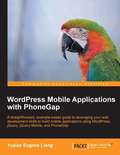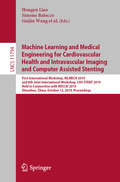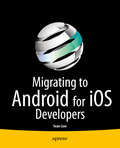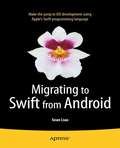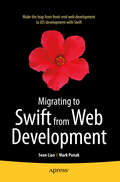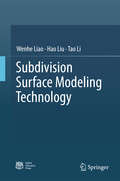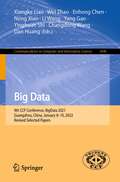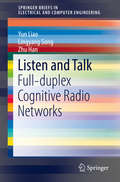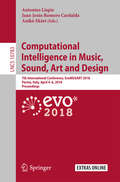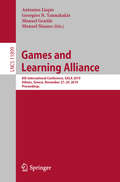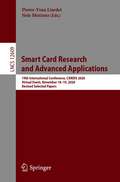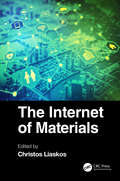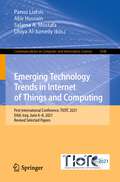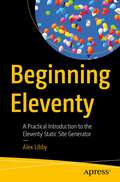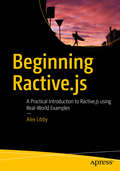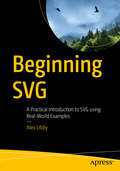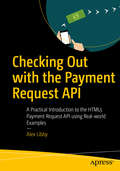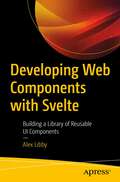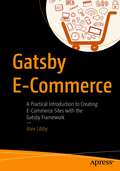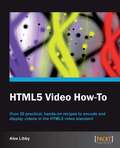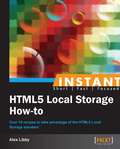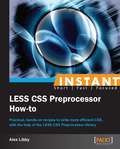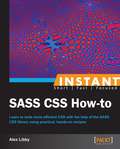- Table View
- List View
Wordpress Mobile Applications with PhoneGap
by Yuxian Eugene LiangThis is a practical step-by-step tutorial. If you are a developer with basic knowledge of Wordpress, HTML/CSS/JavaScript seeking to understand how to further your knowledge in creating cross-platform mobile applications using PhoneGap, then this book is for you.
Dynamics, Uncertainty and Reasoning: The Second Chinese Conference on Logic and Argumentation (Logic in Asia: Studia Logica Library)
by Beishui Liao Thomas Ågotnes Yi N. WangThis volume collects selected papers presented at the Second Chinese Conference on Logic and Argumentation in 2018 held in Hangzhou, China. The papers presented reflect recent advances in logic and argumentation, as well as the connections between the two, and also include invited papers contributed by leading experts in these fields. The book covers a wide variety of topics related to dynamics, uncertainty and reasoning. It continues discussions on the interplay between logic and argumentation which has a long history from Aristotle’s ancient logic to very recent formal argumentation in AI.
Machine Learning and Medical Engineering for Cardiovascular Health and Intravascular Imaging and Computer Assisted Stenting: First International Workshop, MLMECH 2019, and 8th Joint International Workshop, CVII-STENT 2019, Held in Conjunction with MICCAI 2019, Shenzhen, China, October 13, 2019, Proceedings (Lecture Notes in Computer Science #11794)
by Hongen Liao Simone Balocco Guijin Wang Feng Zhang Yongpan Liu Zijian Ding Luc Duong Renzo Phellan Guillaume Zahnd Katharina Breininger Shadi Albarqouni Stefano Moriconi Su-Lin Lee Stefanie DemirciThis book constitutes the refereed proceedings of the First International Workshop on Machine Learning and Medical Engineering for Cardiovasvular Healthcare, MLMECH 2019, and the International Joint Workshops on Computing and Visualization for Intravascular Imaging and Computer Assisted Stenting, CVII-STENT 2019, held in conjunction with MICCAI 2019, in Shenzhen, China, in October 2019. For MLMECH 2019, 16 papers were accepted for publication from a total of 21 submissions. They focus on machine learning techniques and analyzing of ECG data in the diagnosis of heart diseases. CVII-STENT 2019 accepted all 8 submissiones for publication. They contain technological and scientific research concerning endovascular procedures.
Migrating to Android for iOS Developers
by Sean LiaoMigrating to Android for iOS Developers gives you--as an experienced native iOS app developer--the skills to learn native Android apps development from scratch. Starting with preparing your Android integrated development environment and introducing just enough Android application framework fundamentals, you'll understand how to create a simple but meaningful HelloAndroid project immediately. This book provides the guidelines and tutorial projects to show you how to translate your existing iOS app to the Android platform. You'll use your mobile app knowledge to structure your Android apps in a similar way to how you would structure your iOS apps. To implement use cases with detailed screens, the most common mobile topics are discussed, including user interfaces, managing data, and networking with remote services. As you move through the book, you'll create Android apps with rich UI components to handle common CRUD operations locally and remotely. There are many Android goodies described in the book. Instead of relying on routine text descriptions, you'll discover the uniqueness of Android and appreciate the many features that are unique to the platform. This book also explores more powerful mobile UX patterns that are commonly used on the iOS and Android platforms. When you finish reading Migrating to Android for iOS Developers, you'll be an Android developer as well as an iOS developer. And, you will be fully convinced you can do everything in Android that you can do in iOS. What you'll learn * How to maximize your existing iOS mobile knowledge to learn Android programming skills * How to use the Android integrated development environment with the Eclipse ADT plugin * How to translate your existing iOS code to Android with the following common mobile topics: ° Common mobile screen navigation patterns ° User interface components and UI animations ° Storing data ° Networking and using remote services ° Using system apps ° Maps and location awareness ° Mobile search frameworks ° Mobile analytics Who this book is for This book is for iOS app developers--like you--who want to port their native iOS app to become an Android app. Also, if you are not an iOS developer, but already familiar with mobile apps, then this book can also help you understand Android development with step-by-step instructions and tutorial projects. Table of Contents 1. Setup Development Environment 2. Android Programming BasicsChapter 3. Structure your App and Break it into Components 4. Implement Piece by Piece 5. More About Android Application Components 6. Android Application Resources 7. Common Mobile Use Cases 8. Pulling it all together - Recap with a Case Study 9. Appendix
Migrating to Swift from Android
by Sean LiaoIn 250 pages, Migrating to Swift from Android gives you--as an experienced Android app developer--all you need to create native iOS apps using the latest Swift programming language. Starting with preparing your Xcode 6. 1 IDE and introducing just enough iOS application framework fundamentals, you'll understand how to create meaningful Swift applications for iOS 8 immediately. After the short IDE setup guide, this book continues by providing guidance on how to translate your existing Android apps to iOS. Every topic comes with a tutorial project; you'll plan and structure your iOS apps following a typical top-down process using Xcode Storyboards. To implement use cases, you'll cover common mobile topics, including user interfaces, managing data, and networking with remote services. As you move through Part 2 of this book, you'll create simple and meaningful iOS apps with rich UI components to handle common CRUD operations locally and remotely. Part 3 demonstrates the whole porting process by translating a typical mobile app from Android to iOS 8 from start to finish. When you finish reading Migrating to Swift from Android, you'll be an iOS developer as well as an Android developer. And, you will be fully convinced you can create iOS apps just like you do in Android. In most cases, it is a waste not to port your native Android apps to iOS. What you'll learn Maximize your existing mobile knowledge to learn iOS programming Use the latest Xcode 6. 1 IDE Translate your existing GUI Android apps Learn the fundamentals of Swift Work with user interface components and UI animations Store and retrieve data Create networked apps that use remote services Who this book is for This book is for Android developers wanting to make the jump to iOS development using the new Apple Swift programming language. Table of Contents Part 1: Prepare Your Tools 1. Setting Up the Development Environment 2. iOS Programming Basics Part 2: Come Sail Away: A Roadmap for Porting 3. Structure Your App 4. Implement Piece by Piece Part 3: Pulling It All Together 5. Recap with a Case Study
Migrating to Swift from Web Development
by Sean Liao Mark PunakMigrating to Swift From Web Development gives you the ability to create native iOS apps using the latest Swift programming language. Starting with preparing your latest Xcode 6 Integrated Development Environment and introducing just enough iOS application framework fundamentals, you'll understand how to create a simple but meaningful Hello Swift application for iOS 8 immediately. After the short IDE setup guide, this book will show you how to structure your iOS project from an existing mobile web app. Every topic comes with a tutorial project that you will create by yourself. You'll plan and structure your iOS apps using Xcode Storyboard, implementing use cases with detailed screens, and learn about managing data and working with remote services. Finally, you'll experience a recap of the whole porting process by translating a mobile web app to iOS 8 from start to end. When you finish reading Migrating to Swift from Web Development, you'll be an iOS developer as well as a front-end web developer. What you'll learn Swift language and Xcode 6 fundamentals Common mobile screen navigation patterns User Interface components and animations How to store data How to use remote services with your app Who this book is for Front-end web developers, mobile web developers, and JavaScript developers wanting to learn native iOS development with Swift. Table of Contents Part 1: Prepare Your Tools Chapter 1: Setting Up the Development Environment Chapter 2: iOS Programming Basics Part 2: A Roadmap for Porting Chapter 3: Structure Your App Chapter 4: Implement Piece by Piece Part 3: Finishing Touches Chapter 5: Pulling It All Together Chapter 6: Bonus Chapter -- Hybrid Apps
Subdivision Surface Modeling Technology
by Wenhe Liao Hao Liu Tao LiThis book offers a comprehensive introduction to Subdivision Surface Modeling Technology focusing not only on fundamental theories but also on practical applications. It furthers readers’ understanding of the contacts between spline surfaces and subdivision surfaces, enabling them to master the Subdivision Surface Modeling Technology for analyzing subdivision surfaces. Subdivision surface modeling is a popular technology in the field of computer aided design (CAD) and computer graphics (CG) thanks to its ability to model meshes of any topology. The book also discusses some typical Subdivision Surface Modeling Technologies, such as interpolation, fitting, fairing, intersection, as well as trimming and interactive editing. It is a valuable tool, enabling readers to grasp the main technologies of subdivision surface modeling and use them in software development, which in turn leads to a better understanding of CAD/CG software operations.
Big Data: 9th CCF Conference, BigData 2021, Guangzhou, China, January 8–10, 2022, Revised Selected Papers (Communications in Computer and Information Science #1496)
by Xiangke Liao Wei Zhao Enhong Chen Nong Xiao Li Wang Yang Gao Yinghuan Shi Changdong Wang Dan HuangThis book constitutes the proceedings of the 9th CCF Conference on Big Data, BigData 2021, held in Guangzhou, China, in January 2022. Due to the COVID-19 pandemic BigData 2021 was postponed to 2022. The 21 full papers presented in this volume were carefully reviewed and selected from 66 submissions. They present recent research on theoretical and technical aspects on big data, as well as on digital economy demands in big data applications.
Listen and Talk
by Yun Liao Lingyang Song Zhu HanThis brief focuses on the use of full-duplex radio in cognitive radio networks, presenting a novel spectrum sharing protocol that allows the secondary users to simultaneously sense and access the vacant spectrum. This protocol, called "Listen-and-talk" (LAT), is evaluated by both mathematical analysis and computer simulations in comparison with other existing protocols, including the listen-before-talk protocol. In addition to LAT-based signal processing and resource allocation, the brief discusses techniques such as spectrum sensing and dynamic spectrum access. The brief proposes LAT as a suitable access scheme for cognitive radio networks, which can support the quality-of-service requirements of these high priority applications. Fundamental theories and key techniques of cognitive radio networks are also covered. Listen and Talk: Full-duplex Cognitive Radio Networks is designed for researchers, developers, and professionals involved in cognitive radio networks. Advanced-level students studying signal processing or simulations will also find the content helpful since it moves beyond traditional cognitive radio networks into future applications for the technology.
Computational Intelligence in Music, Sound, Art and Design
by Antonios Liapis Juan Jesús Romero Cardalda Anikó EkártThis book constitutes the refereed proceedings of the 7th International Conference on Evolutionary Computation in Combinatorial Optimization, EvoMUSART 2018, held in Parma, Italy, in April 2018, co-located with the Evo*2017 events EuroGP, EvoCOP and EvoApplications. The 21 revised full papers presented were carefully reviewed and selected from 33 submissions. The papers cover a wide range of topics and application areas, including: generative approaches to music and visual art; medical art therapy; visualization in virtual reality; jewellery design; interactive evolutionary computation; and the art theory of evolutionary computation.
Games and Learning Alliance: 8th International Conference, GALA 2019, Athens, Greece, November 27–29, 2019, Proceedings (Lecture Notes in Computer Science #11899)
by Antonios Liapis Georgios N. Yannakakis Manuel Gentile Manuel NinausThis book constitutes the refereed proceedings of the 8th International Conference on Games and Learning Alliance, GALA 2019, held in Athens, Greece, in November 2019. The 38 regular papers presented together with 19 poster papers were carefully reviewed and selected from 76 submissions. The papers cover the following topics: serious game design and pedagogical foundations; AI and technology for SG; gamification; applications and case studies; and posters.The chapter "Cyber Chronix, Participatory Research Approach to Develop and Evaluate a Storytelling Game on Personal Data Protection Rights and Privacy Risks" is available open access under a CC BY 4.0 license at link.springer.com.
Smart Card Research and Advanced Applications: 19th International Conference, CARDIS 2020, Virtual Event, November 18–19, 2020, Revised Selected Papers (Lecture Notes in Computer Science #12609)
by Pierre-Yvan Liardet Nele MentensThis book constitutes the proceedings of the 19th International Conference on Smart Card Research and Advanced Applications, CARDIS 2020, which took place during November 18-20, 2020. The conference was originally planned to take place in Lübeck, Germany, and changed to an online format due to the COVID-19 pandemic. The 12 full papers presented in this volume were carefully reviewed and selected from 26 submissions. They were organized in topical sections named: post-quantum cryptography; efficient implementations; and physical attacks.
The Internet of Materials
by Christos LiaskosState-of-the-art, flat structures called metasurfaces can filter and steer light and sound, render an object completely invisible to electromagnetic waves, and much more. They can deliver automation, remote operation, and advanced performance to a wide variety of existing systems, with applications in communications, medical imaging, sensing, and security. However, for non-specialists, individual metasurfaces are currently restricted to limited reusability and accessibility. This book brings together various scientific disciplines with the aim of outlining a programmable ‘plug-and-play’ metasurface. The book focuses on a recently proposed platform – known as the HyperSurface – that provides many electromagnetic functions of metasurfaces in a single structure, which can be controlled and reconfigured by software. This revolutionary approach paves the way for new opportunities in wireless communications and programmable wireless environments: HyperSurfaces could link networks with objects and physical environments and create smarter systems that are far more responsive to user demands. Walls that absorb radiation or block digital eavesdropping, and wireless, long-distance charging of devices are among the many possibilities. The book aspires to provide the foundational knowledge for creating an Internet of Materials, enabling smart environments at any scale – from indoor wireless communications to medical imaging equipment. Although the set of disciplines involved covers a considerable span, we hope that the material will benefit experts and students alike.
Emerging Technology Trends in Internet of Things and Computing: First International Conference, TIOTC 2021, Erbil, Iraq, June 6–8, 2021, Revised Selected Papers (Communications in Computer and Information Science #1548)
by Panos Liatsis Abir Hussain Salama A. Mostafa Dhiya Al-JumeilyThis volume constitutes selected papers presented at the First International Conference on Emerging Technology Trends in IoT and Computing, TIOTC 2021, held in Erbil, Iraq, in June 2021. The 26 full papers were thoroughly reviewed and selected from 182 submissions. The papers are organized in the following topical sections: Internet of Things (IOT): services and applications; Internet of Things (IOT) in healthcare industry; IOT in networks, communications and distributed computing; real world application fields in information science and technology.
The Routledge Handbook of FinTech (Routledge International Handbooks)
by K. Thomas LiawThe Routledge Handbook of FinTech offers comprehensive coverage of the opportunities, challenges and future trends of financial technology. This handbook is a unique and in-depth reference work. It is organised in six thematic parts. The first part outlines the development, funding, and the future trends. The second focuses on blockchain technology applications and various aspects of cryptocurrencies. The next covers FinTech in banking. A significant element of FinTech, mobile payments and online lending, is included in the fourth part. The fifth continues with several chapters covering other financial services, while the last discusses ethics and regulatory issues. These six parts represent the most significant and overarching themes of FinTech innovations. This handbook will appeal to students, established researchers seeking a single repository on the subject, as well as policy makers and market professionals seeking convenient access to a one-stop guide.
Beginning Eleventy: A Practical Introduction to the Eleventy Static Site Generator
by Alex LibbyLeverage the power of Eleventy to quickly produce static sites that are efficient and fast. This project-oriented book simplifies the process of setting up Eleventy and manipulating content, using little more than a text editor or free software. It will equip you with a starting tool set that you can use to develop future projects or incorporate into your existing workflow. More importantly, you'll take websites to the next level, reducing the reliance on tools that are bloated, prone to being hacked and not the most efficient. Beginning Eleventy is an excellent resource for getting acquainted with creating and manipulating blogs using a static site generator approach. It takes the view that you don’t have to create something complex and unwieldy; you can build something quickly, then extend it using the power of the API and plugins over time, without sacrificing speed or features. What You’ll Learn:Implement the Eleventy framework in a projectExplore some of the options for customizing content using the frameworkGain an appreciation of pointers around maintenance requirements, and how this might compare to other blog systemsWork through some example projects, to help build up a working blog from standalone demos to implementing with other tools or libraries This Book Is For?Website developers who are already familiar with JavaScript, who are looking for a fast and simple framework to deliver high quality results fastDevelopers who are looking to leverage the Eleventy framework to quickly create an online blog using little more than a text editor, producing optimized content in modern browsers using tools they will already haveThose in agile development teams, where time is of the essence and need to deliver high quality results quickly
Beginning Ractive.js: A Practical Introduction to Ractive.js using Real-World Examples
by Alex LibbyDevelop websites using the Ractive. js template-driven UI library. This book is project-oriented and simplifies the process of using Ractive. js to create websites or online applications that are interactive by default. It equips you with a starting toolset to develop future projects, safe in the knowledge that the site operates as expected, and is not reliant on bloated technology, typical of other similar frameworks. Beginning Ractive. js takes the view that you shouldn't always resort to what "everyone else uses", and that there is indeed a different way you can achieve the same result. We live in an age where speed and simplicity are of the essence - this book provides a perfect alternative that challenges the norm. Stop thinking you must use the same library as everyone else. Give Ractive a try! What You'll Learn Understand how Ractive. js works and how it differs to other templating frameworks. templates="" that="" are="" interactive="" from="" the="" outset. Source and manage data using Ractive. js' data binding methods. Gain an appreciation of managing events and animations using Ractive. js. Create components that contain reusability functionality for current or future projects. Work through real-world project examples using the Ractive. js library. Who This Book is For Website developers who are keen to develop a fully interactive, template-driven website quickly, but don't have the desire to learn a more heavyweight framework, such as AngularJS. Agile development teams, where time is of the essence, and the pressure is on to deliver results quickly. Developers who want to focus on simplicity, where the library works for them, and they are not constrained by having to follow a particular methodology.
Beginning SVG: A Practical Introduction to SVG using Real-World Examples
by Alex LibbyDevelop SVG functionality for use within websites quickly and natively, using basic tools such as HTML and CSS. This book is a project-oriented guide to creating and manipulating scalable vector graphics in the browser for websites or online applications, using little more than a text editor or free software, and the power of JavaScript. You'll use a starting toolset to incorporate into your existing workflow, develop future projects, and reduce any dependency on graphics applications for simple projects. This book is an excellent resource for getting acquainted with creating and manipulating SVG content. We live in an age where speed and simplicity are of the essence. Beginning SVG provides a perfect alternative when creating web-based projects that challenges the norm and encourages you to expand your resources and not resort to what “everyone else uses” (such as Illustrator). You'll discover that there is indeed a different way to achieve the same result. Stop thinking you must always resort to using graphics packages; there is always another way!What You'll LearnCreate powerful, optimized content that can be quickly and easily manipulated within the browserGet up to speed with SVG quickly, with minimal effort and maximum resultsSee how easy it is to apply SVG content and effects, without the need for lots of additional tools.Who This Book Is For Website developers and agile development teams who are keen to learn how to add and manipulate SVG quickly.
Checking Out with the Payment Request API: A Practical Introduction to the HTML5 Payment Request API using Real-world Examples
by Alex LibbyQuickly create consistent checkouts for use within websites, using the power of the HTML5 Payment Request API. This project-oriented book simplifies the process of creating and manipulating checkouts with the Payment Request API in browsers for websites or online applications, using little more than a text editor or free software.One of the key concerns of any e-commerce company is ensuring customers complete the checkout process successfully, and for them to return. Unfortunately, many checkouts still suffer from a high level of drop-out. The Payment Request API is an open standard being developed by browser vendors to simplify payments for users with a quick and seamless autofill process enabling a broader set of online payment providers to participate in the market. The API is designed to be easy to implement across all supported browsers, and work with any payment type or service provider. Checking Out with the Payment Request API equips you with a tool set that you can use to develop future projects, incorporate into your existing workflow and allow you to reduce any dependency on complex, custom-made checkouts that might be prone to failure, or unwieldy to use. You'll learn how to use the Payment Request API to create consistent checkouts quickly and easily, and work through practical example projects that will help familiarize you with using the API. We live in an age where speed and accuracy are of the essence – add effortless flow to your payments using this book today. What You'll LearnImplement the Payment Request API in a projectExplore some of the options for personalizing it for a projectGain an appreciation of pointers around user experience and how this affects the APIUnderstand how to manage issues and security when using the Payment Request APIWork through some example projects, from standalone demos to implementing in frameworks Who This Book Is For Website developers familiar with creating shopping carts and looking to leverage the HTML5 Payment Request API. Also ideal for those in agile development teams who want to focus on simplifying content in modern browsers using their existing tools
Developing Web Components with Svelte: Building a Library of Reusable UI Components
by Alex LibbyLeverage the power of Svelte to quickly produce the foundations of a framework-agnostic component library that can extend and develop over time. This is a project-oriented book that simplifies setting up the skeleton of the library and adding components, using little more than a text editor or free software. You'll gain a starting baseline that can be used to develop future projects or incorporated into an existing workflow. You'll take development to the next level and can use this knowledge to create components with any framework, such as React, Angular or Vue.js, not just Svelte. Developing Web Components with Svelte is an excellent resource for getting acquainted with creating and maintaining a component library using a phased approach. It takes the view that you don't have to create something complex and unwieldy. Instead, you can start building something quickly, then extend it as needs dictate over time, without sacrificing speed or features. You'll see how to develop cleaner components in a quick, clear and straightforward way. The components you create in this project can be made available in one of the world's most extensive component ecosystems to be usable by other frameworks, making them genuinely reusable. In short, Svelte offers plenty of opportunities as it is based on Node.js and JavaScript making Svelte a powerful package to work from.What You'll LearnUse the Svelte framework to rapidly create and deploy the foundation of a component library that is versatile and performantReview developing and customizing components based on our needsWork through a real-world project to help solidify skills learned from the book and put them into practiceWho This Book Is ForWebsite developers, familiar with JavaScript, who are keen to learn how to leverage the Svelte framework fastAgile development teams, where time is of the essence, and the pressure is on to deliver results quicklyDevelopers who want to focus on simplicity, to produce efficient and optimized content in modern browsers using tools readily available
Gatsby E-Commerce: A Practical Introduction to Creating E-Commerce Sites with the Gatsby Framework
by Alex LibbyLeverage the power of Gatsby to quickly produce e-commerce sites that are efficient, fast, and secure. This project-oriented book simplifies the process of setting up a Gatsby e-commerce site from start to finish, providing a starting toolset that you can use to develop future projects and incorporate into your existing workflows. You'll learn to reduce reliance on tools that are bloated, prone to being hacked, and not the most efficient, and move over to the newest framework on the block. You'll also see how to use the Gatsby framework to rapidly create and deploy e-commerce sites that are performant and secure, with the minimum of fuss. Understand how to source data, build a catalog, add a blog, finesse your site (including performance), implement the checkout and payment processes with the help of third-party tools such as Stripe, and deploy to production. Finally, you'll learn how to migrate existing WooCommerce sites to Gatsby, and adapt for mobile. Gatsby is fast and does away with the need for databases, thereby removing one of the biggest weak spots in any e-commerce site. It is based on Node.js and JavaScript, making it easy to extend and customize as requirements dictate. Learn to make your customers’ lives easier and simpler using this book today. What You'll Learn Implement e-commerce sites using GatsbyExplore some of the options for architecting an e-commerce site using this frameworkGain an appreciation of pointers around maintenance requirements and ancillary needs (such as SEO)Compare your site to others that use different toolsWork through a project from start to finish, understanding what can be achieved using Gatsby, and where other tools may need to be brought into play Who This Book Is For Developers already familiar with JavaScript, who are keen to learn how to leverage the Gatsby framework to quickly create the basis of an e-commerce offer (from scratch, or using data tools such as WooCommerce to support a transition), with little more than a text editor. Developers who want to focus on simplicity, to produce efficient and properly optimized e-commerce sites in modern browsers using tools already in their possession.Those in agile development teams, where time is of the essence, and the pressure is on to deliver results quickly.
HTML5 Video How-to
by Alex LibbyFilled with practical, step-by-step instructions and clear explanations for the most important and useful tasks. Get the job done and learn as you go. This book takes the How-to series approach to help you learn most important tasks through recipes. This book is great for developers new to the HTML5 Video standard, and who are looking to get a good grounding in how to use the new format. It's assumed that you will have some experience in HTML and jQuery already, as well as being familiar with embedding videos using current "old school" methods, such as Windows Media Player. Readers are expected to have one or more videos available, which will be used during the exercises within this book.
Instant HTML5 Local Storage How-to
by Alex LibbyFilled with practical, step-by-step instructions and clear explanations for the most important and useful tasks. Get the job done and learn as you go. Step-by-step recipes to get to grips with the LocalStorage standard.This book is great for those who maintain sites that use cookies in some form or another, and who want to learn how to take advantage of the LocalStorage standard to improve browser security and store more relevant information that can be retrieved at some point in the future, without recourse to the server.
Instant LESS CSS Preprocessor How-to
by Alex LibbyFilled with practical, step-by-step instructions and clear explanations for the most important and useful tasks. Get the job done and learn as you go. A how-To book with practical recipes accompanied with rich screenshots for easy comprehension.This book takes the How-to series approach to help you learn most important tasks through recipes This book is ideal for those new to using CSS Preprocessors such as LESS, and who are looking to get a good grounding in how to use LESS. It's assumed you will have some experience in using HTML and CSS already; it is likely you will be responsible for maintaining at least one website (the larger the better), and are keen to learn how you can use LESS to help make it easier to manage your CSS styles. Although this book does incorporate some additional code using Modernizr, it is not essential to have had any previous experience with Modernizr.
Instant SASS CSS How-to
by Alex LibbyFilled with practical, step-by-step instructions and clear explanations for the most important and useful tasks. Get the job done and learn as you go. This book is filled with practical, hands-on recipes to help you write SASS quickly and more efficiently.This book is great for those new to using CSS pre-processors such as SASS, and who are looking to get a good grounding in how to use SASS. It's assumed you will have some experience in using HTML and CSS already; it is likely you will be responsible for maintaining at least one website (the larger the better), and are keen to learn how you can use SASS to help make it easier to manage your CSS styles. Although SASS is powered by Ruby, it is not essential to already be familiar with Ruby for the purposes of completing the recipes in this book.
